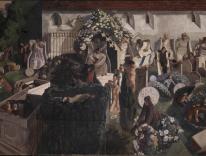Evaluating the worth of critics in 1932, Ezra Pound quite rightly gave the highest praise to readers, like himself, who could strengthen the work of friends like Yeats and Eliot before it was published. The next most valuable critics were those who made discriminating judgments about published works. Finally, Pound condemned those egoistic, careerist critics who drew attention to self and tried to make a name for themselves at the expense of the books under review:
1. The critic most worth respect is the one who actually causes an improvement in the art he criticizes. 2. The best critic of next rank is the one who most focuses attention on the best work. 3. The pestilence masking itself as a critic distracts attention from the best work.
J. M. Coetzee clearly belongs to the second category. He usefully provides the biographical, historical, and cultural background. As a working novelist, he knows how novels work and can speak with authority about technical faults. Saul Bellow’s The Adventures of Augie March suffers from a “lack of dramatic structure and indeed of intellectual organization.” Nadine Gordimer’s The Pickup “is less than perfect in its narrative art.” V. S. Naipaul’s “technical weaknesses are not negligible.” His hero’s love for the girl comes close to cliché. “Half a Life reads like the cut-off first half of a book that might be called A Full Life.” Fluent in German, Coetzee can also judge the quality of translations.
Coetzee is intelligent, perceptive, and lucid; sensitive, generous, and humane: a “decent” man, as Orwell said of Dickens. Always cautious and tactful, he avoids condemnations and prefers fanfare finales. Bellow’s early novel, The Victim, joins Billy Budd “in the first rank of American novellas.” Gordimer’s The Pickup is “not just an interesting book...but an astonishing one.” The “verbal concentration, intensity of feeling, and intellectual range” bring the little-known Belgian writer Hugo Claus “into the first rank of European poets of the late twentieth century.” Similarly, Samuel Beckett’s “language of virile strength and intellectual subtlety mark him as one of the great prose stylists of the twentieth century.” Philip Roth “is a novelist of authentically tragic scope; at his very best he can reach Shakespearean heights.” Coetzee has the erudition of George Steiner, without his academic style and pretension to universal knowledge. Inner Workings is the best book of critical essays since Martin Amis’s dazzling The War Against Cliché (2001).
The order of essays in this book is neither chronological nor linguistic, and Walt Whitman is the cuckoo in the nest of modern writers. It would have been better to discuss the European authors, then the English-language writers, and finally to conclude with Gabriel García Márquez. Coetzee considers twelve foreign heavyweights and nine English-language writers. Six of the writers are still alive; and six—William Faulkner, Beckett, Márquez, Gordimer, Günter Grass, and Naipaul—have won the Nobel Prize (like Coetzee himself). But Robert Musil, Graham Greene, Arthur Miller, Paul Celan, and Philip Roth were as good as, or better than, these winners.
Nine of the authors are Jewish; and eight of the writers, including the five European Jews, had ghastly deaths. Joseph Roth died of alcoholism and delirium tremens. Bruno Schulz was shot by the Nazis. Walter Benjamin, Sándor Márai, and Celan committed suicide. Italo Svevo and the gentile W. G. Sebald died in road crashes. Robert Walser froze to death.
Coetzee’s book is filled with memorable insights and vivid details. Svevo has a “corrosive yet curiously gay scepticism.” Beckett (the subject of Coetzee’s doctoral dissertation) has a “fierce comic anguish...a vision of life without consolation or dignity or promise of grace.” Walser, once a butler in a country house, spent twenty-five years in insane asylums and confessed, “I’m not here to write...I’m here to be mad.” He failed to kill himself because he couldn’t make a proper noose. Walter Benjamin, like Whitman, could not unify his most ambitious work. Like the cut-up snake in the legend, his pieces searched for each other in the dark. Celan, visiting Israel for the first time, ironically marveled, “So many Jews, only Jews, and not in a ghetto.” Naipaul’s “immense feat of self-construction” seems “to have exacted too high a price in denial of the body and its appetites.” Faulkner inspires a rare touch of bleak wit. His early poems, “even with the best will in the world, one cannot call promising.” The Nobel Prize made Faulkner “famous even in America.” In his last years, regarding “himself as pretty much written out,” Faulkner devoted himself to foxhunting, which Coetzee considers a form of barbarous cruelty.
Most of these pieces must have been edited at least twice: once before they appeared in periodicals, again as they were being prepared for this collection. Still, a few errors have crept into Coetzee’s text. The correct Italian is istituto (not instituto), “An Inept” (not “The Inept”) for Un inetto. Naipaul’s Wiltshire is not one of the “home counties.” John Boulting, not Carol Reed, directed the film version of Brighton Rock. And so on.
Coetzee also makes some dubious assertions. Warner Bros. was not, as he writes, “the most stolidly unadventurous of the studios.” Warner Bros. was infinitely more adventurous, realistic, and socially committed than stodgy studios like MGM, which consistently presented a rose-tinted picture of life. Benjamin was not “drawn to universities...as Franz Kafka was drawn to insurance companies.” Benjamin loved scholarship; Kafka hated the bureaucratic drudgery (though he was good at it) that took him away from his passion for writing. The Allies did not have a “coldhearted indifference...to the sufferings of the German population after the war.” Postwar hardships were worse in Britain than in Germany, where the bountiful Marshall Plan did a great deal to alleviate suffering. Coetzee notes Grass’s reference to “the sinking by British planes of...the Cap Ancona, carrying concentration camp survivors.” But he doesn’t mention far greater maritime atrocities committed by the Nazis. On September 27, 1940, the City of Benares, carrying ninety children to Canada, was torpedoed and sunk by a German U-boat, killing nearly three hundred passengers and crew. Orwell alludes to this horror, in which only seven children survived, in Nineteen Eighty-Four. Finally, the discussion of The Misfits deviates into Coetzee’s obsession: cruelty to animals and the real “exhaustion and pain and terror one sees on the screen.” It’s not clear how Coetzee knows the horses were traumatized. But the mustang lassoed at the end by Clark Gable was a tame horse, specifically trained to rear in Hollywood movies.
Coetzee does not attempt to unify his chapters and create a dominant theme. Svevo, for example, tried to write Tuscan Italian in Austrian Trieste; Walser wrote High German while living in Switzerland. Coetzee might have noted, while emphasizing their tragic lives, that Musil, Joseph Roth, and Márai all wrote elegiac novels about the loss of the Hapsburg Empire, as Faulkner did about the loss of the Old South. Another covert theme is the powerful influence of Franz Kafka. Schulz’s Jacob, like Kafka’s Gregor Samsa, actually metamorphosed into a cockroach. The moribund Kafka told his doctor, “If you save me, you’re a murderer,” while Celan, in a psychiatric clinic, lamented, “They’ve healed me to pieces.” Like Kafka, Beckett was “thrown without explanation into an existence governed by obscure rules.” Joseph Roth’s hero, like Kafka’s, had sex “accompanied by silent weeping, like the desperate birthday celebrations of a terminal patient.” Walser felt, as Kafka often did, that he had nothing in himself “worth respecting and watching” and wanted only “to be small and to stay small.” His heroes were persecuted and invited persecution. And he insisted, as Kafka did to his fiancée Felice Bauer, “Only I am capable of bearing myself.”
Related: Edward T. Wheeler’s review of J. M. Coetzee’s Diary of a Bad Year

